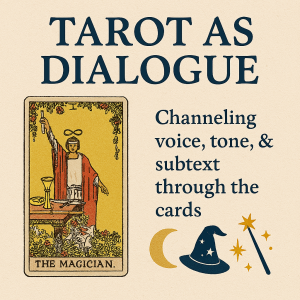Tarot as Dialogue: Channeling Voice, Tone & Subtext Through the Cards

What if your characters spoke like tarot cards?
Not in riddles or fortune-cookie wisdom—but in voices shaped by archetype, emotion, and shadow.
Tarot isn’t just a tool for plotting or character development—it’s a mirror for dialogue. Each card carries a tone, a rhythm, a wound. When you write dialogue through the lens of tarot, you tap into emotional subtext that feels mythic, raw, and real.
Let’s explore how.
 Why Tarot Works for Dialogue
Why Tarot Works for DialogueTarot cards are emotional archetypes. They speak in metaphor, tension, and transformation. When you assign a card to a character—or to a specific scene—you gain access to:
Voice: How they speak (direct, poetic, evasive, commanding)Tone: The emotional flavor (grief, longing, defiance, awe)Subtext: What they’re really saying beneath the wordsThink of it as channeling. You’re not writing dialogue—you’re divining it.
 Major Arcana as Voice Templates
Major Arcana as Voice TemplatesHere’s how a few Major Arcana cards shape character voice:
CardVoice StyleTone/SubtextThe MagicianPersuasive, clever, rhythmic“I control the narrative.”The High PriestessQuiet, cryptic, layered“I know more than I say.”The EmpressSensual, nurturing, poetic“I want you to feel safe—but I need to be seen.”The EmperorCommanding, clipped, formal“I won’t show weakness.”The LoversVulnerable, romantic, torn“I’m choosing between desire and duty.”DeathCalm, inevitable, sparse“This is the end—and the beginning.”The DevilSeductive, mocking, intense“You already said yes.”The StarHopeful, dreamy, gentle“I still believe in you.”
Prompt: Choose a card and write a scene where your character speaks in its voice. Then flip the card—what’s the shadow version of that voice?
 Minor Arcana as Emotional Texture
Minor Arcana as Emotional TextureThe suits add nuance to tone and emotional subtext:
Cups: Emotional, intuitive, longing. Dialogue is soft, indirect, full of pauses and sighs.Swords: Sharp, intellectual, defensive. Dialogue cuts, deflects, rationalizes.Wands: Passionate, impulsive, visionary. Dialogue bursts, interrupts, inspires.Pentacles: Grounded, cautious, practical. Dialogue is slow, deliberate, rooted in reality.
Prompt: Write the same line of dialogue four ways—once for each suit. Notice how the emotional weight shifts.
 Dialogue Ritual: Tarot Spread for a Scene
Dialogue Ritual: Tarot Spread for a SceneBefore writing a scene, pull three cards:
Voice Card – How does the character speak?Tone Card – What emotion colors their words?Subtext Card – What truth hides beneath the surface?Example:
Voice: Knight of Swords → fast, blunt, righteousTone: Five of Cups → grief, regretSubtext: The Moon → confusion, hidden motivesDialogue might sound like:
“You think I wanted this? I did what I had to. You weren’t there. You didn’t see what I saw.”
 Final Reflection: Dialogue as Divination
Final Reflection: Dialogue as DivinationWhen you write dialogue through tarot, you’re not just crafting words—you’re channeling emotional truth. You’re letting archetypes speak through your characters, revealing wounds, desires, and transformations they may not even understand yet.
Let your dialogue be a ritual. Let your characters speak in spells.



